Power Pitch
Imaging of Cancer in the Body
ISMRM & ISMRT Annual Meeting & Exhibition • 10-15 May 2025 • Honolulu, Hawai'i

| 15:45 |
 |
Screen Number: 1
1065. Comparison
of Postoperative Recurrence Prediction Capability among CEST,
DWI, PET/CT and Combined Indexes in Stage I Non-Small Cell Lung
Cancer
Y. Ozawa, K. Yamamoto, M. Ozaki, M. Ikedo, M. Yui, H.
Nagata, T. Ueda, M. Nomura, T. Yoshikawa, D. Takenaka, Y.
Ohno
Fujita Health University School of Medicine, Toyoake, Japan
Impact: MRI-based molecular information has better
potential for prediction of postoperative recurrence than
FDG-PET/CT in stage I NSCLC patients. Moreover, combined
CEST and DWI information can improve prediction capability
of CEST imaging in this setting.
|
| 15:47 |
 |
Screen Number: 2
1066. Predicting
lung cancer chemotherapy efficacy with extracellular volume
fraction and intravoxel incoherent motion parameters
h. han, w. guo, x. lin, h. hao, x. li, m. tian, h. ren, j.
xin, p. zhao
Shandong Provincial Hospital Affiliated to Shandong First Medical University, jinan, China
Impact: IVIM and ECV are potential tools for predicting
early chemotherapy efficacy in lung cancer, creating new
opportunities to refine initial treatment plans and improve
patient prognosis, particularly for those who are resistant
to chemotherapy.
|
| 15:49 |
 |
Screen Number: 3
1067. Combining
Intratumoral and Peritumoral Multimodal MRI to Predict the HER-2
Expression Level in Breast Cancer
W. Feng, M. Qu, Y. Xiong, K. Ji, W. Dang, Z. Wang, M. Xie,
P. Dang, J. Lei
First Hospital of Lanzhou University, Lanzhou, China
Impact: This study’s findings could enhance non-invasive
HER-2 status assessment in breast cancer, aiding clinicians
in personalized treatment planning. It opens avenues for
further research on multimodal MRI’s role in predicting
other molecular characteristics, improving diagnostic
precision.
|
| 15:51 |
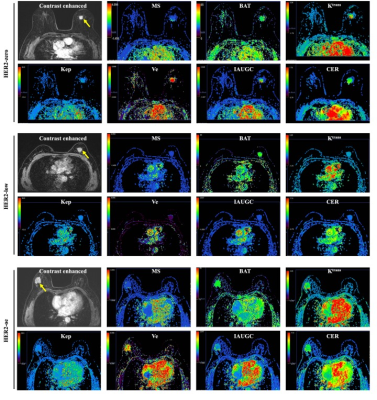 |
Screen Number: 4
1068. The
value of ultra-fast DISCO DCE in identifying HER2 zero-, low-,
and over-expressing breast cancers
T. Zhan, J-k Dai, C-h Lu
Department of Radiology, The Second Affiliated Hospital of Nanchang University, Nanchang, China
Impact: Our results suggested ultra-fast DISCO DCE
derived quantitative kinetic parameters can serve as
non-invasive biomarkers for identifying HER2-zero, HER2-low,
and HER2-oe. The application of DISCO DCE would be
beneficial for guiding treatment selection and monitoring
HER2 status change during treatment.
|
| 15:53 |
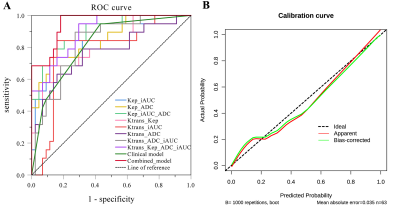 |
Screen Number: 5
1069. Predictive
value of combined DCE-MRI perfusion parameters and clinical
features nomogram for microsatellite instability in colorectal
cancer
L. Peng, W. Ma, X. Zhang, F. Ma, F. Zhang, K. Ai, L. Wang
Gansu University of Chinese Medicine, Lanzhou, China
Impact: MSI CRC is resistant to 5-FU chemotherapy but
benefits from neoadjuvant immunotherapy and targeted
therapy. The nomogram model provides a good non-invasive and
individualized tool for predicting MSI, avoiding the risks
associated with invasive pathological detection.
|
| 15:55 |
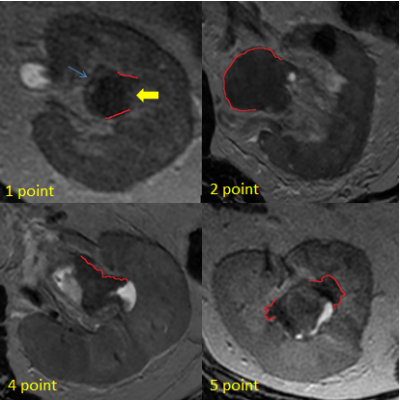 |
Screen Number: 6
1070. Prediction
of muscle invasion in upper urinary tract urothelial carcinoma
using 3D reduced-FOV CUBE T2 with deep learning reconstruction
H. Zhang, Y. Wang, Q. Wang, H. Zheng, Y. Yuan, L. Deng, Y-G
Bao, B. Zhang, H. Liang, B. Song
Sichuan University West China Hospital, Chengdu, China
Impact: The visualization of irregular attachment
surfaces using 3D rFOV CUBE T2 with DLR offers a new
perspective for predicting muscle invasion in UTUC. This
could assist patients without irregular attachment surfaces
in avoiding radical nephroureterectomy.
|
| 15:57 |
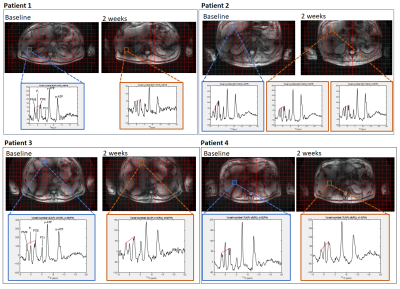 |
Screen Number: 7
1071. Early
Treatment Response Evaluation Using 31P MRSI at 7T in Liver
Metastases of 4 Patients With Gastroesophageal Cancer Given
Systemic Treatment
S. Siegerink, B. Runderkamp, A. Bakermans, M. Gosselink, N.
Haj Mohammad, A. Nederveen, D. Klomp, H. van Laarhoven, J.
Prompers
Amsterdam UMC, Amsterdam, Netherlands
Impact: This study shows promising results of 31P
MRSI to evaluate systemic therapy response after only 2
weeks in patients with liver metastases of gastroesophageal
cancer.
|
| 15:59 |
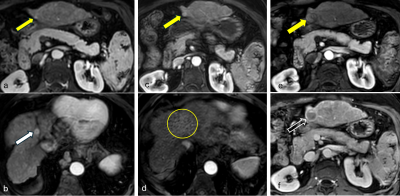 |
Screen Number: 8
1072. Long-Term
Prognosis of Indeterminate Lesions in the Cirrhotic Liver:
Insights from the LI-RADS 3 Neutral Category
A. Bahsoun, J. Ramirez, M. Reed, R. Rajeev, R. Chahine, V.
Gulani, M. Mendiratta-Lala, A. Aslam, S. Wells, H. Hussain
University of Michigan, Ann Arbor, United States
Impact: The findings including key predictors of LR-3
lesion progression such as post-treatment liver status,
larger lesion size, co-existence of other LR3+ lesions,
older age, and alcoholic cirrhosis—offer guidance for
personalized surveillance intervals and efficient resource
allocation for HCC-risk patients.
|
| 16:01 |
 |
Screen Number: 9
1073. Prospective
Investigation of the Value of Arterial Spin Labeling for
Evaluating Bladder Cancer
E. Guo, G. Zhang, L. Chen, J. Zhu, B. Kuehn, J. Zhang, X.
Zhang, X. Bai, Q. Peng, Y. Wu, Z. Jin, H. Sun
Peking Union Medical College Hospital, Peking Union Medical College, Chinese Academy of Medical Sciences, Beijing, China
Impact: Non-invasive and quantitative arterial spin
labeling is a valuable technique for evaluating bladder
cancer because it enables quantifying tumor perfusion and
offers insights into the physiological and pathological
processes.
|
| 16:03 |
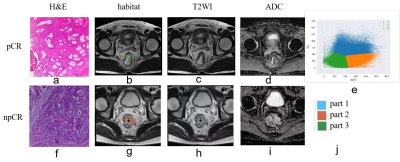 |
Screen Number: 10
1074. Baseline
MRI habitat imaging for predicting treatment response to
neoadjuvant chemoradiotherapy in locally advanced rectal cancer
M. He, H. Chen, M. Ma, F. Xue
Shengli Clinical College of Fujian Medical University & Department of Radiology, Fujian Provincial Hospital, Fuzhou University Affiliated Provincial Hospital, Fuzhou 350001, China
Impact: Habitat models built exclusively with
first-order histogram features provide a more accurate
representation of biological characteristics. Additionally,
a hybrid model was developed by integrating clinical
features with habitat features, enhancing model
interpretability and acceptance by radiologists.
|
| 16:05 |
 |
Screen Number: 11
1075. Noninvasive
grading of clear cell renal cell carcinoma using MRI cytometry
X. Jiang, D. Joyce, J. Gore, J. Xu
Vanderbilt University Medical Center, Nashville, United States
Impact: This technique could reduce biopsies and improve
RCC diagnosis, grading, and treatment decisions.
|
| 16:07 |
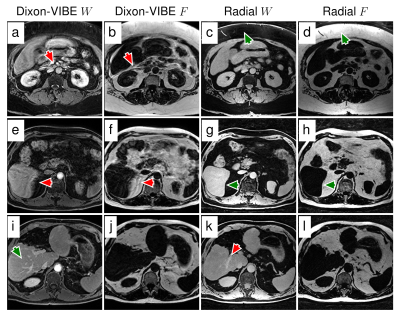 |
Screen Number: 12
1076. Towards
Free-Breathing Nodal Staging of Upper Abdominal Cancers:
MRI-Visible Nodal Size Distributions and Uptake of USPIO
Nanoparticles
T. Scheenen, M. Maas, K. Tobias Block, R. van den Elshout,
A. Veltien, E. Smit, J. Hermans, I. Maatman
Radboud university medical centre, Nijmegen, Netherlands
Impact: Our method effectively depicts LNs and visualize
their USPIO uptake in the upper abdomen. All relevant
parameters are obtained from a single free-breathing radial
acquisition, yielding higher image quality and more
sensitive detection of small lymph nodes.
|
| 16:09 |
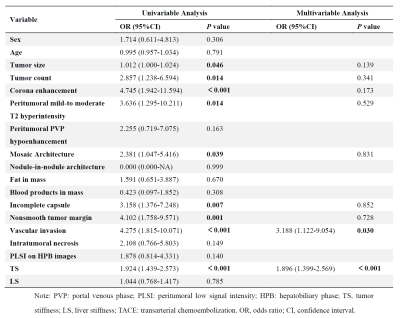 |
Screen Number: 13
1077. 3D
MR Elastography-based Stiffness as a Marker for Predicting
Hepatocellular Carcinoma Refractory to Transarterial
Chemoembolization
Y. Wang, J. Zhou, Y. Zeng, Z. Fang, S. Ouyang, J. Chen, M.
Yin, K. Glaser, R. Ehman, J. Wang
The Third Affiliated Hospital, Sun Yat-Sen University (SYSU), GuangZhou, China
Impact: 3D MRE-based tumor stiffness is a promising
biomarker for predicting TACE refractory HCC. The MRE-based
model might be a useful tool for evaluating TACE refractory
HCC.
|
| 16:11 |
 |
Screen Number: 14
1078. Phosphorus
Metabolite Profiling of Hepatocellular Carcinoma Using 31P-MRS:
A Comparative Study with Surrounding Liver Tissue
J. Li, H. Lin, F. Yan, P. Wu
Ruijin Hospital, Shanghai, China
Impact: These metabolic shifts in HCC lesions may aid
in diagnosis and monitoring of liver cancer.
|
| 16:13 |
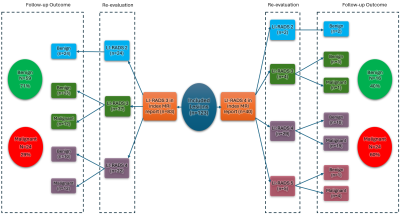 |
Screen Number: 15
1079. Inter-observer
Agreement for the Diagnosis of LI-RADS 3 and 4 Lesions on
Gadoxetate MRI and Outcome Assessment
M. Yuce, S. Lewis, A. Villanueva, B. Taouli
Icahn School of Medicine Mount Sinai, New York, United States
Impact: The study highlights the need for improved
standardization and radiologist’s training in applying
LI-RADS criteria to enhance diagnostic accuracy.
|
| 16:15 |
 |
Screen Number: 16
1080. Diagnostic
Performance of LI-RADS v2024 Radiation Treatment Response
Algorithm: A Multi-Reader Study with Pathologic Correlation
W. Han, C. Wang, N. Zhang, C. Adler, M. Zulfiqar, K.
Sandrasegaran, A. Silva
Mayo Clinic, Scottsdale, United States
Impact: This first validation study of LI-RADS v2024
radiation TRA shows excellent inter-reader agreement and
diagnostic performance, supporting its clinical
implementation for standardized post-radiation therapy
response assessment in HCC patients.
|
| 16:17 |
 |
Screen Number: 17
1081. Value
of Quantitative DCE-MRI restaging the Status of Regional Lymph
Nodes With a Short-Axis Diameter ≥ 5 mm for Rectal Cancer
Z. Zhang, Y. Chen, Y. Wu, S. Yu
National Cancer Center/National Clinical Research Center for Cancer/Cancer Hospital & Shenzhen Hospital,Chinese Academy of Medical Sciences and Peking Union Medical College, Shenzhen, China
Impact: Quantitative DCE-MRI can improve the accuracy of
nodal restaging in rectal cancer after neoadjuvant therapy,
and subsequently conducive to therapeutic evaluation and
formulation of next treatment strategies.
|
| 16:19 |
Screen Number: 18
1082. WITHDRAWN |
|
| 16:21 |
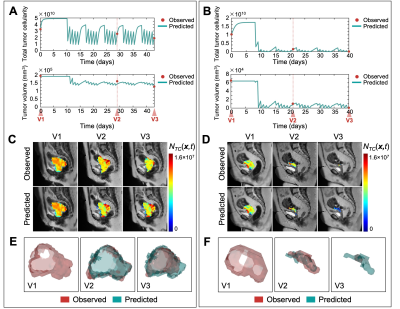 |
Screen Number: 19
1083. Applying
an MRI-based mathematical model to predict the response of
cervical cancer to chemoradiation: Preliminary results
R. Patel, C. Wu, C. Stowers, R. Mohamed, J. Ma, G. Rauch, T.
Yankeelov
The University of Texas at Austin, Austin, United States
Impact: Our biology-based mathematical model using
quantitative MRI data has the potential to accurately
predict tumor response to chemoradiation for patients with
locally advanced cervical cancer.
|
| 16:23 |
 |
Screen Number: 20
1084. Differentiation
of Cervical Cancer and Pathological Type Using Quantitative
Microstructural Parameters of MRI cytometry
W. Yue, R. Han, D. Zheng, H. Li, Q. Yang
Beijing Chaoyang Hospital, Capital Medical University, Beijing, China
Impact: For the first time, MRI cytometry demonstrated
the feasibility and superior diagnostic capability in
noninvasively differentiating cervical intraepithelial
neoplasia (CIN) from cervical cancer (CC)and identifying CC
pathological types.
|
| 16:25 |
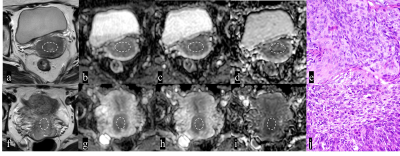 |
Screen Number: 21
1085. Oscillating
Gradient Diffusion-Weighted MRI in diagnosing cervical cancer
and evaluating the degree of pathological differentiation
J. j. Li, Y. Xiao, J. Guo, Y. Hao, R. Zhang, Y. Zhu, K. Ai
The First Affiliated Hospital of Xi'an Jiaotong University , Xi’an, China
Impact: This study confirms the advantages of
Oscillating Gradient Diffusion-Weighted MRI parameters in
the pathological differentiation of cervical cancer,
especially for diagnosing cervical cancer, offering greater
accuracy than traditional ADCPGSE.
|
| 16:27 |
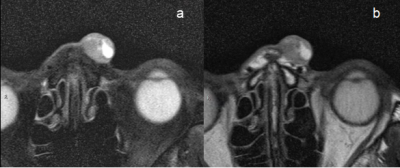 |
Screen Number: 22
1086. Evaluating
Tumor Features and Invasion in Non-melanoma Skin Cancer by High
Resolution MRI
X. Li, Y. Liang, W. Dai, Y. Peng, Y. Jiang, Y. Meng
Taiyuan Central Hospital, Taiyuan, China
Impact: This study demonstrates that HR-MRI effectively
evaluates tumor features and invasion levels in non-melanoma
skin cancer, enhancing preoperative assessment accuracy and
potentially reducing the need for secondary surgeries,
thereby improving patient management and surgical outcomes.
|
| 16:29 |
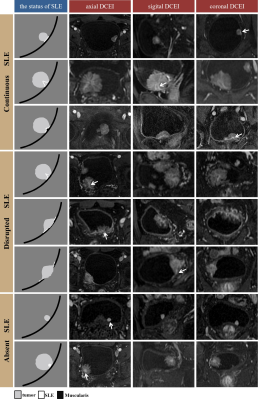 |
Screen Number: 23
1087. Submucosal
Linear Enhancement in Adjusted VI-RADS: Enhancing Detection of
Muscle-Invasive Bladder Cancer Using Isotropic DCE-MRI
X. Zhang, Y. Wang, S. Wang, Y. Chen, X. Zhao
National Cancer Center/National Clinical Research Center for Cancer/Cancer Hospital, Chinese Academy of Medical Sciences and Peking Union Medical College, Beijing, China
Impact: Incorporating submucosal linear enhancement
(SLE) into the VI-RADS system significantly improves
the detection of muscle-invasive bladder cancer. This
adjustment could lead to earlier, more accurate staging and
treatment planning, ultimately enhancing patient outcomes by
reducing missed diagnoses of MIBC.
|
| 16:31 |
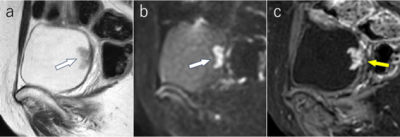 |
Screen Number: 24
1088. Impact
of Tumor Shape on Local Staging Accuracy Using VI-RADS in
Bladder Cancer: Implications for MRI Protocol Selection
Y. Arita, T. Kwee, K. Shigeta, N. Nissan, Y. Lin, R. Ishii,
S. Masuyama, H. Edo, S. Fransen, C. Roest, J. Das
Memorial Sloan Kettering Cancer Center, New York, United States
Impact: This study highlights the importance of
considering tumor morphology in MRI protocols for bladder
cancer. The use of DCE-MRI is crucial for accurate staging
of sessile/broad-based tumors.
|
| 16:33 |
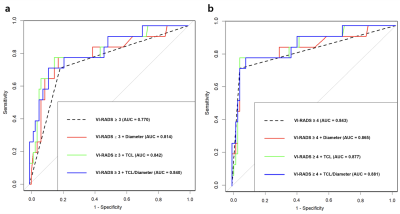 |
Screen Number: 25
1089. A
Prospective Study on VI-RADS and Tumor Contact Length for
Predicting Muscle-Invasive Bladder Cancer with MRI
M. J. Kim, C. K. Kim
Samsung Medical Center, Seoul, Korea, Republic of
Impact: Integrating TCL with VI-RADS enhances MIBC
diagnostic accuracy, potentially influencing treatment
strategies and improving patient outcomes. This study lays
groundwork for further exploration of TCL’s role in cancer
imaging, paving the way for more precise and personalized
bladder cancer care.
|
The International Society for Magnetic Resonance in Medicine is accredited by the Accreditation Council for Continuing Medical Education to provide continuing medical education for physicians.